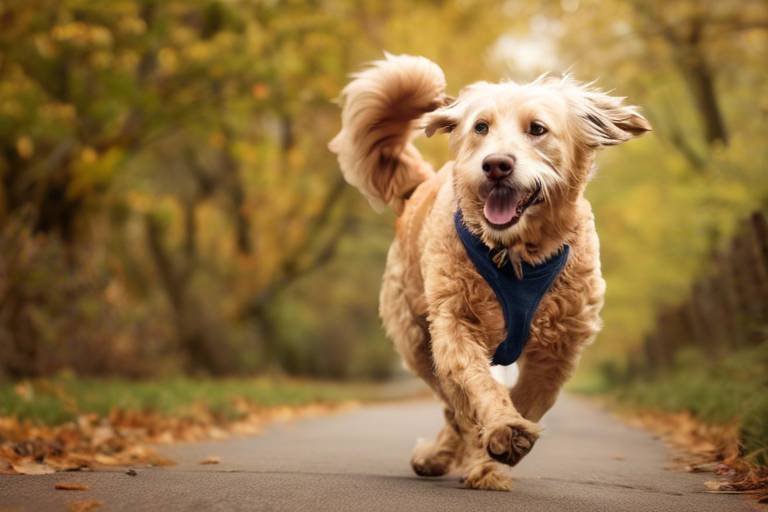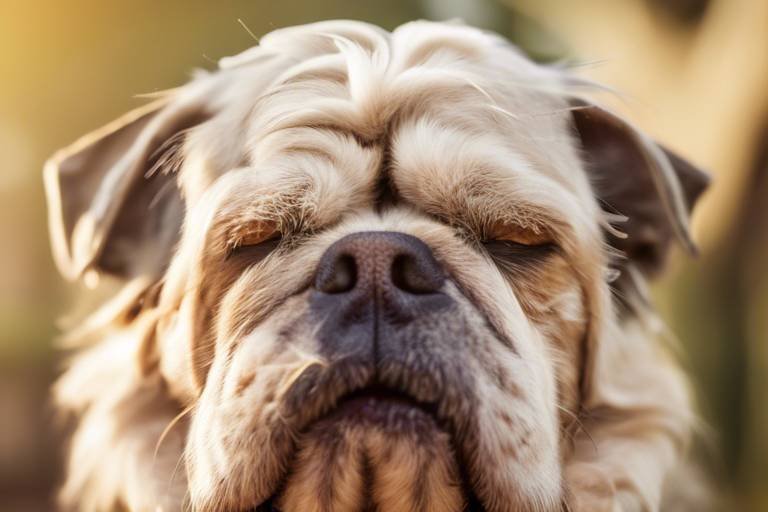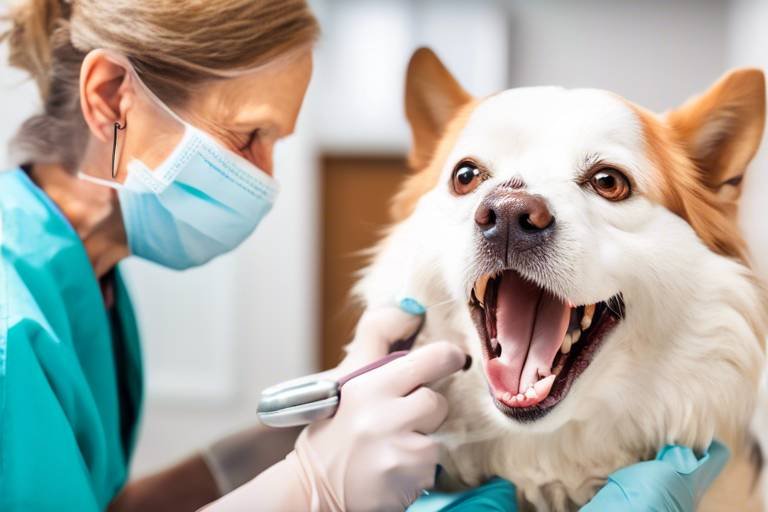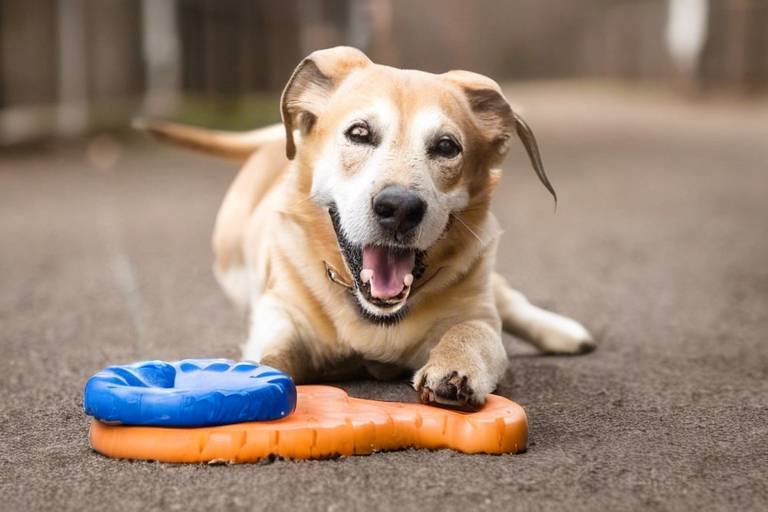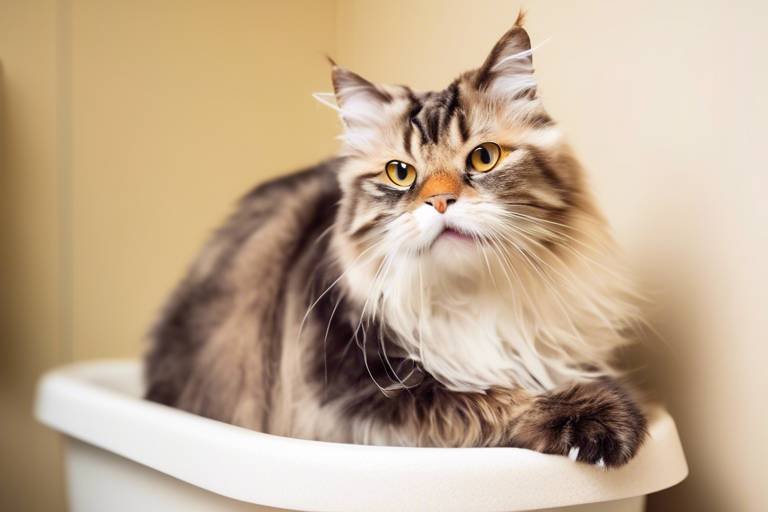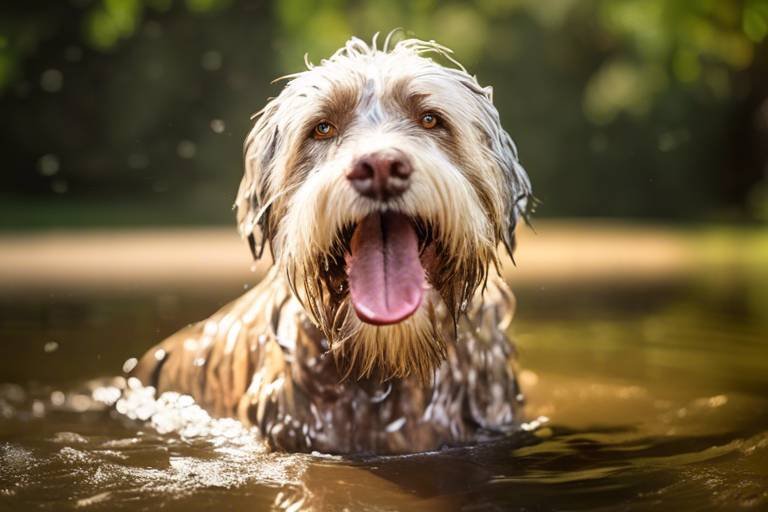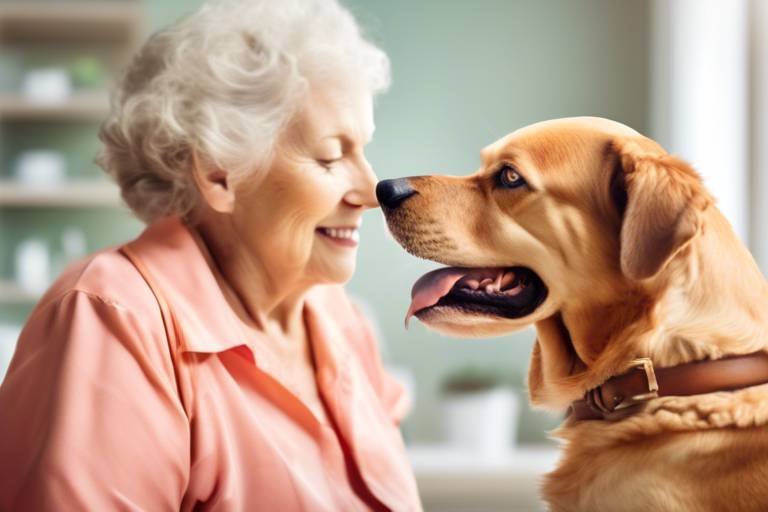The Importance of Keeping Senior Pets Active
As our beloved furry companions age, it becomes crucial to recognize the importance of keeping them active. Just like humans, senior pets need regular exercise to maintain their health and happiness. Imagine a lively dog bounding through a park or a cat playfully chasing a feather toy; these moments are not just cute—they're essential for their well-being. An active lifestyle can significantly enhance the quality of life for senior pets, helping them stay agile, maintain a healthy weight, and keep their minds sharp.
Regular exercise is not merely a luxury; it’s a necessity that can lead to a healthier, longer life for our aging pets. Think of it this way: if you were to sit still all day, every day, how would you feel? Bored? Stiff? Unmotivated? Senior pets can feel the same way when they don't get enough movement. By keeping them active, we can help mitigate common health issues and improve their overall mood. It's like giving them a dose of happiness and vitality that can last well into their golden years.
However, maintaining an active lifestyle for senior pets comes with its own set of challenges. As they age, pets may develop health problems that can limit their mobility and energy levels. Conditions like arthritis, obesity, and heart disease are common in older pets, making it essential for pet owners to adapt their exercise routines accordingly. But don’t worry! With the right knowledge and a bit of creativity, you can tailor activities that keep your senior pet engaged and active without risking their health.
In this article, we’ll delve into the myriad benefits of keeping senior pets active, address common health issues they face, and provide practical tips for creating a safe and enjoyable exercise routine. Whether it’s a gentle stroll around the block or a fun game of fetch, there are plenty of ways to ensure your furry friend remains lively and joyful. So, grab their favorite toy, and let’s explore how to keep those tails wagging!

Benefits of Regular Exercise
This article explores the significance of maintaining an active lifestyle for senior pets, discussing the benefits, challenges, and practical tips to ensure their well-being and happiness in their golden years.
Regular exercise is not just a luxury for senior pets; it's a necessity. As our furry friends age, their bodies undergo various changes that can affect their overall health and happiness. Engaging in regular physical activity offers a multitude of benefits that can significantly enhance their quality of life. Think of exercise as the fountain of youth for your pet. It helps keep their joints flexible, their weight in check, and their minds sharp. The importance of exercise cannot be overstated, as it plays a pivotal role in ensuring that your senior pet enjoys a vibrant and fulfilling life.
One of the primary benefits of regular exercise is improved mobility. Just like humans, pets can become stiff and less agile as they age. Regular movement helps maintain joint function and flexibility, allowing them to move around comfortably. Imagine a dog that once sprinted through the park now struggling to get up from a cozy nap. With consistent exercise, you can help your pet regain some of that lost mobility, making everyday activities like walking or playing fetch enjoyable once again.
Another crucial aspect is weight management. Senior pets are prone to gaining weight, which can lead to a host of health problems, including diabetes and heart disease. By incorporating regular exercise into their routine, you can help keep their weight in check. This doesn't mean you have to turn your living room into a gym; simple activities like short walks or gentle play sessions can do wonders. In fact, a balanced combination of exercise and a healthy diet can be the key to preventing obesity-related complications.
Moreover, regular exercise provides essential mental stimulation. Just like their bodies, pets' minds also need to stay active. Engaging in playful activities can help keep their brains sharp and reduce feelings of anxiety or boredom. Think of it as a workout for their minds! Activities that challenge them, like puzzle toys or interactive games, can stimulate their cognitive functions, making them feel more engaged and happy.
To put it simply, the benefits of regular exercise for senior pets can be summarized as follows:
- Improved Mobility: Keeps joints flexible and reduces stiffness.
- Weight Management: Helps prevent obesity-related health issues.
- Mental Stimulation: Keeps their minds sharp and engaged.
- Enhanced Mood: Regular activity can lead to a happier pet.
In conclusion, keeping your senior pet active is vital for their overall well-being. By understanding the numerous benefits of regular exercise, you can take proactive steps to ensure that your furry friend enjoys their golden years to the fullest. Just like us, pets thrive on routine, and incorporating regular activity into their lives can lead to a healthier, happier, and more fulfilling existence.
Senior pets often face various health issues such as arthritis, obesity, and heart problems. Understanding these conditions helps pet owners tailor appropriate activities to keep their furry friends active without risking injury.
Managing arthritis in senior pets is crucial for their comfort. Gentle exercises can alleviate stiffness and pain, promoting better joint health and overall mobility as they age gracefully.
Engaging in low-impact activities like swimming or walking on soft surfaces can provide effective exercise for arthritic pets, reducing strain while keeping them active and healthy.
Incorporating therapeutic exercises, such as stretching and range-of-motion activities, can significantly enhance a senior pet's flexibility and comfort, supporting their overall fitness regime.
Maintaining a healthy weight is vital for senior pets. Implementing a balanced diet and regular exercise routine can help prevent obesity-related health complications and enhance their quality of life.
Establishing a consistent exercise routine tailored to the pet's abilities is essential. Gradually increasing activity levels can help seniors adapt and enjoy physical activity while avoiding overexertion.
Playtime is not only enjoyable for senior pets but also an excellent way to keep them active. Engaging in interactive games can stimulate their minds and bodies, fostering a sense of joy and vitality.
Regularly monitoring a senior pet's activity levels ensures they are neither overworked nor under-exercised. Keeping track of their physical capabilities helps pet owners adjust routines as necessary for optimal health.
Consulting a veterinarian is crucial for developing a safe exercise plan for senior pets. Professional guidance can help address specific health concerns and recommend appropriate activities tailored to individual needs.
Q: How much exercise does my senior pet need?
A: The amount of exercise varies based on the pet's breed, size, and health condition. Generally, aim for short, regular sessions of 15-30 minutes a day, adjusting as needed.
Q: Can my senior pet still play fetch?
A: Yes, but modify the game to suit their abilities. Use softer toys and shorter distances to prevent overexertion.
Q: What signs should I look for to know if my pet is overdoing it?
A: Watch for signs of fatigue, excessive panting, limping, or reluctance to continue. If you notice any of these, it's time for a break.
Q: Are there specific exercises I should avoid?
A: High-impact activities, such as jumping or running on hard surfaces, should generally be avoided, especially for pets with joint issues.

Understanding Common Health Issues
As our beloved furry companions age, they often encounter a variety of health issues that can affect their quality of life. Understanding these common problems is essential for pet owners who want to keep their senior pets happy and active. One of the most prevalent issues is arthritis, a degenerative joint condition that can lead to pain and stiffness. This condition can make even the simplest activities, like walking or climbing stairs, a challenge for our pets. Regular exercise, tailored to their abilities, can help manage this discomfort.
Another significant concern is obesity, which can exacerbate existing health problems and lead to new ones, such as diabetes and heart disease. Senior pets tend to be less active, which can contribute to weight gain. As pet owners, it’s crucial to monitor their diet and encourage gentle exercise to maintain a healthy weight. A balanced diet rich in nutrients and low in empty calories can make a world of difference.
Additionally, senior pets are at an increased risk for heart problems. Conditions such as congestive heart failure can develop as pets age, affecting their stamina and energy levels. It's vital to keep an eye on their breathing patterns and energy levels during exercise. If you notice any unusual behavior, such as excessive panting or lethargy, it’s time to consult your veterinarian.
To help you better understand these health issues, here’s a summary of common conditions faced by senior pets:
| Health Issue | Description | Management Strategies |
|---|---|---|
| Arthritis | A degenerative joint disease causing pain and stiffness. | Gentle exercise, weight management, and anti-inflammatory medications. |
| Obesity | Excess body weight leading to various health complications. | Balanced diet, portion control, and regular low-impact exercise. |
| Heart Problems | Conditions affecting the heart’s ability to function properly. | Regular vet check-ups, controlled exercise, and a heart-healthy diet. |
By understanding these common health issues, pet owners can take proactive steps to tailor their senior pet's exercise regimen. Keeping their physical limitations in mind while encouraging activity can greatly enhance their overall well-being. Remember, it’s not just about keeping them moving; it’s about ensuring they enjoy their golden years with vitality and joy.
- What are the signs of arthritis in senior pets? Look for signs like limping, reluctance to jump or climb stairs, and noticeable stiffness after resting.
- How can I help my overweight senior pet? Consult your vet for a tailored diet plan and gradually introduce low-impact exercises like walking.
- When should I consult a veterinarian about my senior pet's health? If you notice sudden changes in behavior, appetite, or energy levels, it’s best to seek professional advice.
Arthritis Management
Managing arthritis in senior pets is not just about keeping them comfortable; it's about enhancing their quality of life. Imagine your furry friend, once a ball of energy, now moving slowly and hesitantly. Arthritis can be a silent thief, robbing them of their joy and mobility. However, with the right approach, you can help your pet reclaim some of that lost vitality.
First and foremost, understanding the nature of arthritis is crucial. This degenerative joint disease causes inflammation and pain in the joints, making even simple activities like walking or jumping a challenge. By recognizing the signs—such as limping, reluctance to move, or changes in behavior—you can take proactive steps to manage their condition. Gentle, regular exercise is one of the most effective ways to alleviate stiffness and pain. Think of it as a daily dose of medicine, but in the form of movement.
When it comes to exercise, low-impact activities are your best friends. Activities like swimming or walking on soft surfaces can provide the necessary movement without putting undue stress on their joints. Not only does this help maintain their physical health, but it also boosts their mood. After all, who wouldn’t feel happier after a refreshing swim or a leisurely stroll in the park?
Furthermore, incorporating therapeutic exercises into their routine can significantly enhance their flexibility and comfort. Consider activities that involve gentle stretching or range-of-motion exercises. These can be done at home and are particularly beneficial for pets with arthritis. Just picture your pet enjoying a gentle stretch, much like how we feel after a good yoga session—rejuvenated and ready for more!
To further illustrate the importance of arthritis management, here’s a quick overview of some effective strategies:
| Strategy | Description |
|---|---|
| Gentle Exercise | Engaging in low-impact activities to maintain mobility. |
| Weight Management | Keeping your pet at a healthy weight to reduce joint strain. |
| Therapeutic Exercises | Incorporating stretching and range-of-motion activities. |
| Pain Management | Using vet-recommended medications to alleviate discomfort. |
In addition to these strategies, it's essential to create a warm and comfortable environment for your senior pet. Providing soft bedding, avoiding slippery surfaces, and ensuring easy access to their favorite spots can make a world of difference. Remember, every little adjustment counts when it comes to managing arthritis.
Lastly, never hesitate to consult with your veterinarian. They can provide tailored advice and may recommend specific treatments or therapies to support your pet's health. After all, a healthy pet is a happy pet, and with the right management, your furry friend can continue to enjoy their golden years with grace and vitality.
- What are the signs of arthritis in pets? Look for limping, reluctance to jump or climb stairs, and changes in behavior.
- Can exercise help my pet with arthritis? Yes, gentle exercise can alleviate stiffness and improve mobility.
- What types of low-impact activities are best? Swimming, walking on soft surfaces, and therapeutic exercises are great options.
- Should I consult a vet for my pet's arthritis? Absolutely! A veterinarian can provide tailored advice and treatments.
Low-Impact Activities
When it comes to keeping our senior pets active, are a fantastic way to ensure they get the exercise they need without putting unnecessary strain on their joints. As pets age, their bodies may not be as resilient as they once were, making it crucial to choose activities that are gentle yet effective. Think of it like a gentle stroll through the park rather than a sprint; it’s all about maintaining a pace that suits their comfort level.
One of the most enjoyable low-impact activities for senior pets is swimming. Not only is it a great full-body workout, but the buoyancy of the water helps to alleviate pressure on their joints, allowing them to move freely without pain. Imagine your furry friend gliding through the water, their tail wagging with joy as they splash around. It's not just good for their physical health; it's also a wonderful way to stimulate their minds and keep them engaged.
Another excellent option is walking on soft surfaces, such as grass or sand. These surfaces provide a cushioned landing for their paws, reducing the risk of injury while still allowing them to enjoy the great outdoors. A leisurely walk can be a bonding experience as well, giving you both the chance to explore new scents and sights together. Plus, it’s a fantastic way for you to get some fresh air and exercise too!
Incorporating gentle stretching exercises into your senior pet's routine can also be beneficial. Just like us, pets can benefit from a good stretch to maintain flexibility and prevent stiffness. You can start by encouraging them to stretch their legs and back gently. This can be done while they’re lying down or standing, and it’s a simple way to enhance their overall mobility. Think of it as a mini yoga session for your furry friend!
Finally, consider engaging in interactive play that doesn’t involve too much running or jumping. Activities like tossing a soft toy or playing hide-and-seek at a slow pace can keep your pet active while ensuring they don't overexert themselves. These moments of play not only provide physical exercise but also enrich their mental well-being, keeping their spirits high in their golden years.
In summary, low-impact activities are essential for keeping senior pets both physically fit and mentally stimulated. By choosing the right exercises, you can help your furry companions maintain a happy, active lifestyle while ensuring their comfort and safety. After all, every wag of their tail and every playful bounce is a testament to the joy you bring into their lives.
- What are some signs my senior pet needs more exercise? Look for signs like weight gain, lethargy, or difficulty getting up. If they seem less enthusiastic about their usual activities, it might be time to introduce more exercise.
- How do I know if an activity is suitable for my senior pet? Always consult with your veterinarian before starting a new exercise routine. They can provide guidance based on your pet's specific health needs.
- Can senior pets still play fetch? Yes, but modify the game to suit their energy levels. Use softer toys and keep the throws short to prevent overexertion.
- How often should I exercise my senior pet? Aim for short, frequent sessions throughout the week, adjusting based on their stamina and health condition.
Therapeutic Exercises
When it comes to keeping our senior pets comfortable and active, play a pivotal role. These exercises are specifically designed to enhance flexibility, strength, and overall mobility, making them an essential part of a senior pet's fitness regime. Just like humans benefit from stretching and gentle movements, our furry friends do too! Think of it as a gentle dance that not only keeps their bodies limber but also brings joy to their hearts.
Incorporating therapeutic exercises into your senior pet's routine can significantly improve their quality of life. For instance, stretching exercises not only help alleviate stiffness but also promote blood circulation, which is crucial for healing and maintaining healthy muscles and joints. Imagine if you were sitting all day; your body would feel stiff and sluggish. The same goes for our pets! Therefore, introducing a few simple stretches can work wonders. Here are some effective therapeutic exercises you might consider:
- Gentle Neck Stretches: Encourage your pet to turn their head side to side gently. This helps maintain neck flexibility.
- Leg Lifts: While your pet is standing, gently lift each leg one at a time to strengthen their muscles.
- Range-of-Motion Exercises: Move your pet's legs in a circular motion to keep their joints healthy and flexible.
It's important to approach these exercises with care. Start slowly, and always monitor your pet's reaction. If they seem uncomfortable, it’s best to ease off and consult with a veterinarian for guidance. The goal is to promote movement without causing any pain or discomfort. Think of these exercises as a warm hug for their joints, providing comfort while keeping them active.
Additionally, incorporating these exercises into a regular routine can help your pet associate movement with positive experiences. You can even turn it into a fun bonding time! Play some soft music, and create a calm environment that invites your pet to stretch and move. Remember, the key is consistency; just a few minutes each day can make a significant difference over time.
Don't forget to reward your pet after each session! A little treat or some extra cuddles can reinforce their willingness to engage in these therapeutic activities. After all, who doesn’t love a little pampering after a good workout? By making therapeutic exercises a regular part of your senior pet's life, you're not just keeping them active; you're also enhancing their overall well-being and happiness.
Q: How often should I incorporate therapeutic exercises into my senior pet's routine?
A: Ideally, aim for short sessions of therapeutic exercises several times a week, gradually increasing the frequency as your pet becomes more comfortable.
Q: What should I do if my pet shows signs of discomfort during exercises?
A: If your pet appears to be in pain or discomfort, stop the exercise immediately and consult your veterinarian for advice tailored to your pet's specific needs.
Q: Can I do therapeutic exercises with my pet at home?
A: Absolutely! Many therapeutic exercises can be done at home. Just ensure you create a safe space and consult with your vet for the best practices.
Weight Management Strategies
Maintaining a healthy weight is absolutely vital for senior pets, as it can significantly impact their overall health and quality of life. As pets age, their metabolism slows down, making it easier for them to gain weight. This is where a well-thought-out weight management strategy comes into play. Just like humans, pets benefit from a balanced diet and regular exercise, and the right combination can help keep them fit and happy.
One of the first steps in managing your senior pet's weight is to consult with your veterinarian. They can help you understand your pet's ideal weight and assess any underlying health issues that may affect their weight. After all, every pet is unique, and what works for one may not work for another. Your vet can also recommend a nutritionally balanced diet tailored to your pet's specific needs, which is crucial for maintaining their health.
When it comes to diet, portion control is key. Many pet owners unknowingly overfeed their furry friends, thinking they're showing love with extra treats. Instead, consider measuring out their food and sticking to a feeding schedule. You can also incorporate low-calorie treats into their diet, such as carrots or green beans, which can satisfy their cravings without adding unnecessary calories. Remember, treats should not make up more than 10% of their daily calorie intake.
In addition to diet, regular exercise is essential for weight management. However, it’s important to tailor the exercise routine to your senior pet's abilities. Here are some effective strategies:
- Short, Frequent Walks: Instead of one long walk, consider taking your pet on several shorter walks throughout the day. This approach can help maintain their energy levels and prevent fatigue.
- Interactive Play: Engage your pet in interactive games like fetch or tug-of-war. These activities not only provide physical exercise but also stimulate their minds.
- Swimming: If your pet enjoys water, swimming can be an excellent low-impact exercise that is easy on their joints.
Tracking your pet's progress is also an essential part of any weight management strategy. Keeping a log of their weight, food intake, and exercise routines can help you identify patterns and make necessary adjustments. You might even create a simple table to visualize their progress:
| Date | Weight (lbs) | Food Intake (cups) | Exercise Duration (minutes) |
|---|---|---|---|
| 01/01/2023 | 25 | 2 | 30 |
| 01/15/2023 | 24.5 | 2 | 35 |
| 02/01/2023 | 24 | 2 | 40 |
Lastly, remember that patience is key. Weight management is a gradual process, and it's essential to celebrate small victories along the way. By being proactive and making informed choices, you can help your senior pet achieve and maintain a healthy weight, ensuring they enjoy their golden years to the fullest.
Q: How often should I exercise my senior pet?
A: It's best to engage in short, frequent sessions of exercise throughout the day, rather than one long session. This helps keep them active without overexerting them.
Q: What are some signs my pet is overweight?
A: Look for signs such as difficulty in walking or playing, excessive panting, or an inability to feel their ribs when you gently press on their sides.
Q: Can I give my senior pet human food?
A: Some human foods are safe for pets in moderation, like fruits and vegetables. However, always check with your veterinarian before introducing new foods to ensure they are safe.

Creating an Exercise Routine
Establishing a consistent exercise routine for your senior pet is not just a good idea; it’s essential for their overall well-being. Think of it like setting a rhythm to a beautiful song; when the tempo is just right, everything flows harmoniously. The key is to tailor the routine to your pet's unique abilities and preferences, ensuring that they enjoy the activities while also benefiting from them. Start by assessing your pet’s current fitness level. Are they spry and energetic, or do they prefer lounging around? This initial evaluation will guide you in crafting a plan that keeps them engaged without pushing them too hard.
Gradually increasing activity levels is a smart approach. Just like humans, senior pets need time to adapt to new routines. Begin with short sessions of gentle exercise, such as a leisurely stroll around the block or a few minutes of playtime with their favorite toy. As your furry friend becomes more comfortable, you can incrementally extend the duration and intensity of the activities. This gradual increase is crucial to avoid overexertion, which can lead to injuries or fatigue.
Incorporating a variety of exercises into the routine can also keep things fresh and exciting. For instance, mixing low-impact activities such as:
- Swimming
- Walking on soft surfaces
- Gentle fetch games
can provide a well-rounded fitness regimen. Each of these activities targets different muscle groups and offers unique benefits, contributing to your pet's overall health.
Another important aspect of an exercise routine is the timing. Try to find a time of day when your pet is most active and alert. Early mornings or late afternoons are often ideal, as the weather is typically cooler, making it more comfortable for your senior pet to engage in physical activities. Plus, this schedule can help establish a routine that both you and your pet look forward to.
Lastly, don’t forget to include playtime in your exercise routine. Play is not only fun; it’s also a fantastic way to stimulate your senior pet both mentally and physically. Interactive games, such as tug-of-war with a soft toy or gentle hide-and-seek around the house, can boost their mood and keep them agile. Remember, the goal is to create a routine that is enjoyable and beneficial, enhancing the quality of life for your beloved companion in their golden years.
- How often should I exercise my senior pet? Aim for at least 20-30 minutes of activity most days of the week, adjusting based on their energy levels and health conditions.
- What types of exercises are best for senior pets? Low-impact activities such as swimming, walking, and gentle play are ideal for keeping senior pets active without straining their joints.
- How can I tell if my pet is overexerted? Watch for signs like excessive panting, limping, or reluctance to continue. If you notice these, it’s time to take a break.
- Should I consult a vet before starting an exercise routine? Yes! A veterinarian can provide personalized advice based on your pet’s health status and specific needs.
Incorporating Playtime
When it comes to keeping our senior pets active, playtime is a golden opportunity that should never be overlooked. Just like humans, pets thrive on interaction and engagement, and playtime is a fantastic way to achieve that. Imagine the joy on your furry friend's face as they chase after a toy or engage in a gentle game of tug-of-war. These moments not only provide physical exercise but also stimulate their mental faculties, keeping their minds sharp and their spirits high.
Engaging in interactive games is vital for senior pets. These games can range from simple fetch to more complex puzzle toys that challenge their problem-solving skills. For instance, you might consider using toys that dispense treats when your pet figures out how to manipulate them. This not only keeps them physically active but also mentally stimulated, which is crucial as they age. Variety is key—mixing up the types of play can prevent boredom and keep your pet looking forward to their play sessions.
One of the best parts about incorporating playtime is that it can be easily tailored to fit your pet's individual needs and abilities. For example, if your senior dog loves to chase but has trouble running, you can modify the game by rolling a ball instead of throwing it. This way, they can still enjoy the thrill of the chase without overexerting themselves. Similarly, for cats, consider using feather wands or laser pointers that allow them to engage in playful pursuits without the need for strenuous jumping or running.
Moreover, incorporating playtime into your senior pet's daily routine can be beneficial for both of you. Not only does it strengthen the bond between you and your pet, but it also provides a structured way to ensure they are getting the exercise they need. Set aside specific times during the day for play sessions, and make it a fun ritual. You might even find that these moments become the highlight of your day, bringing joy and laughter into your home.
To make playtime even more enjoyable and effective, consider the following tips:
- Choose the right toys: Opt for soft, lightweight toys that won't cause injury, and ensure they are easy for your pet to carry or manipulate.
- Monitor their energy levels: Always keep an eye on your pet's stamina. If they seem tired or disinterested, it might be time to take a break.
- Be patient: Some senior pets may take longer to engage or may need encouragement to play. Be patient and gentle in your approach.
In conclusion, incorporating playtime into your senior pet's life is not just a fun activity; it’s a vital component of their overall health and happiness. By making play a priority, you are investing in their well-being, ensuring that their golden years are filled with joy, vitality, and cherished moments together. So grab that ball, pull out the feather wand, and let the games begin!
Q: How much playtime should my senior pet have each day?
A: Ideally, aim for at least 15-30 minutes of playtime daily, but adjust based on your pet's energy levels and health condition.
Q: Are there specific toys that are better for senior pets?
A: Yes, look for soft, lightweight toys that are easy to handle and won’t cause injury. Puzzle toys that dispense treats can also be great for mental stimulation.
Q: What if my senior pet doesn’t seem interested in playing?
A: It’s important to be patient. Try different types of play or toys to see what sparks their interest. Sometimes, a gentle nudge or a change of scenery can reignite their enthusiasm.
Monitoring Activity Levels
Monitoring your senior pet's activity levels is like keeping a pulse on their overall health and happiness. Just as we humans track our fitness and well-being, our furry friends deserve the same attention. It’s not just about counting steps; it’s about understanding their unique needs and ensuring they maintain a healthy balance between activity and rest. So, how do we effectively monitor their activity levels?
First off, it’s essential to establish a baseline of what is normal for your pet. Every pet is different, and their activity levels can vary based on breed, age, and health conditions. For example, a senior Labrador may have different exercise needs compared to a senior Persian cat. Keeping a daily log can be incredibly helpful, noting down how much they move, play, and rest. This log can help you spot patterns, identify any sudden changes, and adjust their routine accordingly.
To make this process easier, consider creating a simple table to track their daily activity:
| Date | Activity Type | Duration (minutes) | Comments |
|---|---|---|---|
| 01/01/2023 | Walk | 30 | Seemed energetic |
| 01/02/2023 | Playtime | 20 | Less active than usual |
| 01/03/2023 | Swimming | 15 | Enjoyed it! |
In addition to logging activities, pay attention to your pet’s behavior during and after exercise. Do they seem tired or pant excessively? Are they reluctant to engage in their favorite activities? These signs can indicate that they are either overworked or not getting enough exercise. It’s important to strike a balance, as too much activity can lead to injuries, while too little can result in weight gain and muscle atrophy.
Another effective strategy is to set up a routine that incorporates both structured exercise and free play. For instance, a mix of short walks, gentle play sessions, and interactive games can keep them engaged without overwhelming them. This not only helps maintain their physical health but also stimulates their minds, which is crucial for their overall well-being.
Lastly, consider using technology to assist in monitoring their activity levels. Many pet owners are turning to smart collars and fitness trackers designed for pets. These gadgets can provide real-time data on your pet’s movement, heart rate, and even sleeping patterns. By utilizing these tools, you can gain deeper insights into your pet’s health and make informed decisions about their exercise routine.
In conclusion, keeping an eye on your senior pet's activity levels is vital for their health and happiness. By tracking their movements, understanding their behavior, and adjusting their routines accordingly, you can help ensure they enjoy their golden years to the fullest. Remember, a happy and active pet is a healthy pet!
- How much exercise does my senior pet need? The amount of exercise varies by breed and health condition, but generally, 20-30 minutes of gentle activity daily is a good starting point.
- What are signs that my pet is overexerted? Look for excessive panting, reluctance to continue, or signs of discomfort. If you notice these, it’s time for a break!
- Can I use a fitness tracker on my pet? Yes! Many pet-specific fitness trackers can help you monitor your pet’s activity levels and overall health.

Consulting a Veterinarian
When it comes to keeping our senior pets active, is not just a good idea; it's essential. Your furry friend may have unique health concerns that require tailored exercise plans. Just like how we wouldn’t embark on a fitness journey without a coach, our pets deserve that same level of care and expertise. A veterinarian can provide invaluable insights into the specific needs of your senior pet, taking into account their age, weight, and any underlying health issues.
During your visit, the vet will likely conduct a thorough examination to assess your pet's overall health. This includes checking for common ailments such as arthritis, heart disease, or obesity. Understanding these conditions is crucial because they can significantly influence the type and intensity of exercise your pet can safely handle. For instance, a dog with arthritis may benefit from gentle stretching exercises rather than high-impact activities, while a cat with weight issues might need a different approach altogether.
Moreover, your veterinarian can recommend specific activities that align with your pet’s capabilities. This could include:
- Low-impact exercises: Swimming or walking on soft surfaces can be easier on their joints.
- Therapeutic exercises: Stretching and range-of-motion activities to enhance flexibility.
- Weight management tips: Dietary recommendations to maintain a healthy weight.
It's also important to discuss any behavioral changes you may have noticed in your senior pet. Are they less enthusiastic about playtime? Do they seem more tired than usual? These observations can provide the veterinarian with clues about your pet's health status and help them devise a more effective exercise plan. Remember, a proactive approach can lead to a longer, healthier life for your beloved companion.
In conclusion, consulting a veterinarian is a vital step in ensuring that your senior pet remains active and happy. They can help you navigate the challenges of aging and provide you with a personalized exercise regimen that keeps your pet's unique needs in mind. After all, a healthy pet is a happy pet, and there’s nothing more rewarding than seeing your furry friend thrive in their golden years.
Here are some common questions pet owners have when it comes to keeping their senior pets active:
- How often should I exercise my senior pet? It depends on their health status, but generally, short, frequent sessions are better than long, strenuous ones.
- What signs should I look for to know if my pet is overexerting themselves? Watch for excessive panting, limping, or reluctance to continue exercising.
- Are there specific diets recommended for senior pets? Yes, a diet lower in calories and higher in fiber can help manage weight while still providing necessary nutrients.
Frequently Asked Questions
- Why is regular exercise important for senior pets?
Regular exercise is crucial for senior pets as it helps improve their mobility, manage weight, and provides mental stimulation. Just like us, pets need to stay active to maintain their health and happiness as they age. Think of it as keeping their engines running smoothly!
- What are common health issues faced by senior pets?
Senior pets commonly face health issues such as arthritis, obesity, and heart problems. Understanding these conditions allows pet owners to tailor activities that keep their furry friends active without risking injury. It's all about knowing their limits while keeping them engaged!
- How can I manage my pet's arthritis?
Managing arthritis in senior pets involves incorporating gentle exercises that alleviate stiffness and pain. Activities like slow walks or swimming can be beneficial. Remember, it's about keeping them moving without pushing them too hard!
- What are some low-impact activities for senior pets?
Low-impact activities such as swimming, walking on soft surfaces, or gentle play can effectively keep senior pets active. These activities reduce strain on their joints while ensuring they get the exercise they need. It's like taking a leisurely stroll in the park!
- How can I create an exercise routine for my senior pet?
To create an exercise routine, start by assessing your pet's abilities and gradually increase their activity levels. Consistency is key! Think of it as building a habit; small steps lead to big improvements over time.
- What role does playtime have in keeping senior pets active?
Playtime is not just fun; it's an excellent way to keep senior pets active! Engaging in interactive games stimulates both their minds and bodies, fostering a sense of joy and vitality. It's like a mini workout that they actually enjoy!
- How can I monitor my senior pet's activity levels?
Regularly monitoring your senior pet's activity levels is essential. Keep track of how much they exercise and make adjustments as needed. This ensures they are neither overworked nor under-exercised, much like keeping an eye on a garden to ensure it thrives!
- When should I consult a veterinarian about my senior pet's exercise plan?
Consulting a veterinarian is crucial for developing a safe exercise plan tailored to your senior pet's specific needs. They can address health concerns and recommend appropriate activities, ensuring your furry friend stays active and healthy!

